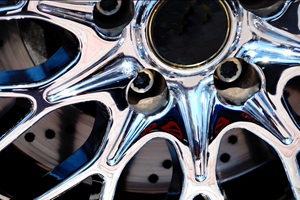Achieving Desired Thickness with Black Passivate
Curt Sotera of Columbia Chemical offers insights for achieving the desired results when plating parts in zinc-nickel with a black passivate.

Sotera
Q. We are plating automotive parts in zinc-nickel with a black passivate. Our plating thickness drops down from 8 to 6 microns after we run it through the passivate and our nickel percentage ends up out of range. To achieve the thickness needed, we end up having to over plate. What is causing this and how can we address it?
You are encountering an extremely common problem when plating to meet zinc-nickel black specs and typically the root cause is related to the passivate. Responding to the demand for longer warranty periods, the automotive and agricultural equipment industries became a major catalyst for growth in the zinc-nickel market over the past decade. As that segment grew, trivalent black passivates for zinc-nickel were rapidly in demand. The industry responded with the development of trivalent black passivates for zinc-nickel that used a simple, one-component system. Though convenient, the driving technology behind this single component black passivate frequently causes three areas of concern for platers:
Decreased plating thickness
Most of the single component trivalent black passivates aggressively dissolve the zinc, leaving a nickel-rich layer. These systems are nitric-based and rely on the tarnishing of the nickel to blacken it. The aggressive nature of the process dissolves enough of the zinc in the alloy to cause a decrease in the overall plating thickness. Many shops respond to this by over plating to achieve the original desired thickness.
Nickel percentage out of range
As you have discovered, a secondary problem often caused by an older technology single component process is a nickel percentage that goes out of range. The zinc is attacked and dissolved by the aggressive passivate leaving the nickel, thus increasing the percentage of nickel in the alloy, causing it to go out of the 12-18% range, resulting in a failed spec.
Increased time & decreased throughput
To compensate for the decreased plating thickness, shops commonly over plate to end up at the desired thickness, leading to increased time and decreased throughput. Let’s look at an example of a shop with an eight-station tank that needs to over plate to increase thickness due to the aggressiveness of the passivate: they add another 15 minutes in plating time to get the desired thickness. With eight stations x 15 minutes, this results in an additional two hours added. This leads to a 20% decrease in throughput and a corresponding increase in labor and operation costs.
In addition to these three common concerns already identified, it is worth noting that over plating and running at a lower pH to thicken the layer can also lead to iridescence on the final part. Finally, if you are plating a part with complex geometry and low current density in the recessed areas, those areas will be particularly subject to being stripped by the aggressiveness of the passivate, which will lead to salt spray failure.
Now that we have looked at these frequent areas of concern and identified the likely root cause as the aggressive dissolving of zinc that is common with single component passivates, we can discuss how to address it. A basic issue to look at is agitation — it is important to have good agitation in the passivate solution for complete coverage and uniform passivation film. A recirculation pump is often recommended, or air agitation is acceptable. You will also want to double-check the pH and temperature of your bath to ensure they are falling within the operating ranges recommended by your chemistry supplier.
The main area to address your concerns comes down to the technology behind the passivate. In short, it is important to have a process that allows you to have greater control over the passivate. Though simple to operate in theory, the single component trivalent black passivate systems are based on older technology and provide a lack of control and little recourse to correct the areas of concern.
As the zinc-nickel market segment of the industry has grown, significant advancements have been made with zinc-nickel tri black passivates and newer technology is now offered which allows more control. There are multi-component systems available that are far less aggressive to the zinc layer while still achieving a desirable black appearance. These passivates allow for less plating time, which provides a higher throughput. They also help maintain a consistent alloy before and after passivating, which helps keep plating shops in line with their specifications’ thickness and salt spray requirements.
Although the single component systems are quite simple to operate, the aggressive dissolving of the zinc within this older technology leaves many plating shop managers wary of spending excess money and time over plating to achieve the thickness and nickel range desired. Evaluating the newer technology, multi-component passivates that allow greater control should help address your concerns to meet your specs, decrease your rejects and increase your throughput.
Curt Sotera is a Technical Account Manager for Columbia Chemical. Visit columbiachemical.com
Related Content
Troubleshooting Alkaline Zinc
One of the most common problems that can arise when plating with alkaline zinc is an imbalance of brightener in the solution. In this helpful Ask the Expert article, Chad Murphy of Columbia Chemical discusses how different zinc metal concentrations and brightener concentrations can impact efficiency.
Read MoreProducts Finishing Reveals 2023 Qualifying Top Shops
Each year PF conducts its Top Shops Benchmarking Survey, offering shops a tool to better understand their overall performance in the industry. The program also recognizes shops that meet a set of criteria to qualify as Top Shops.
Read MoreA Chromium Plating Overview
An overview of decorative and hard chromium electroplating processes.
Read MoreHow to Choose Between Sulfate and Chloride-Based Trivalent Chromium
There are several factors to consider when choosing between sulfate and chloride-based baths for trivalent chromium plating. Mark Schario of Columbia Chemical discusses the differences and what platers should keep in mind when evaluating options.
Read MoreRead Next
Delivering Increased Benefits to Greenhouse Films
Baystar's Borstar technology is helping customers deliver better, more reliable production methods to greenhouse agriculture.
Read MoreEpisode 45: An Interview with Chandler Mancuso, MacDermid Envio Solutions
Chandler Mancuso, technical director with MacDermid Envio discusses updating your wastewater treatment system and implementing materials recycling solutions to increase efficiencies, control costs and reduce environmental impact.
Read MoreEducation Bringing Cleaning to Machining
Debuting new speakers and cleaning technology content during this half-day workshop co-located with IMTS 2024.
Read More










.jpg;maxWidth=300;quality=90)










